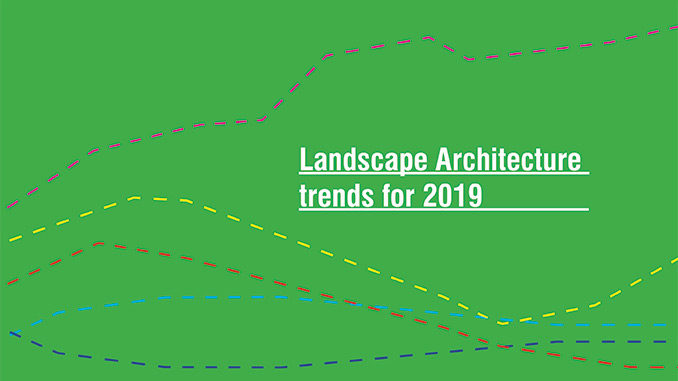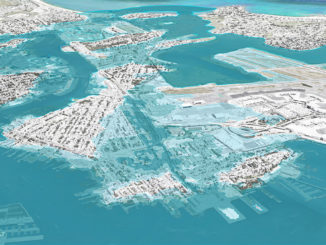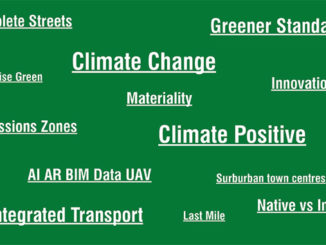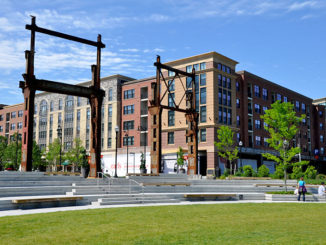
For the past two years, I have written posts about future trends in landscape architecture for the coming year and feel that 2019 will provide us with some interesting landscape architecture trends. But
Revisiting 2018 trends predictions
- climate adaptation is a long-term trend and is an area that will increase in importance for many landscape architects as cities increase budgets to mitigate possible future problems
- terrorism and security with more cities looked to design spaces based on risk assessments
- temporary cities were not as influential as I thought due to less movement (reported movement) of people across borders, however, in 2019, it may increase with the temporary cities in Tijuana and other Mexican cities on the border.
- modeling and data gathering increased in importance as we look to use data to improve the design of spaces
- alternative transport such as private bikes and scooters have come (and also gone) from many cities
inclusive design will still important in the future as cities densify and should be championed by all landscape architects- nature play was a trend in 2018 with play equipment suppliers releasing designs and experiment that use more natural materials in a free-form style
- return to sketching has increased through the release of cheaper iPads with pen capability and mixed media
- VR was not a big trend in 2018 as venture capital investment boom of 2015-2017 tapered off with only some new headsets coming to market. AR is seeing some interesting developments that will start to see in late 2019-2021
- the use of BIM by landscape architects is growing mostly driven by governments and architects requiring projects to be delivered using BIM
continuous design was not a trend in 2018 as this requires business and cultural shift for landscape architects- maintenance was a trend with more companies, governments moving to electric equipment.
- residential homes did see more wireless system based products.
- landscape architects have marginally increased in profile due to the efforts of landscape
organisations and individuals.
2019 trend predictions
During 2018 I spent some time reading landscape architecture books and research papers along with talking to various firms and I think the following maybe trends in 2019 and through into the next decade.
Climate Change studies and new initiatives
In recent years there have been several design competitions (such resilient by design challenge) have produced design solutions for mitigating and integrating climate change into waterfronts and cities along with some projects kicking off over the past five years (in reaction extreme weather events). There will be more public and private funding that will allow for more studies, pilot projects and initiatives to help provide solutions to the largest issue facing the world.
New Infrastructure with Landscape Focus
As cities increase in density (whilst also some cities seeking to
Old Infrastructure reuse, re-appropriation
Many cities have old or abandon infrastructure that can be reused or re-appropriated and transformed to provided spaces for residents. As developments and infill make it too expensive (or unpalatable) for cities to purchase sites for open space they will turn to disused linear infrastructure (rail, rivers, roads) to create open spaces and green networks (green necklaces of the 21st century). Although the Highline, Beltline and Lowline have increased awareness of utilising disused infrastructure for public use, these have also been seen (rightly or wrongly) as gentrification projects which leads us to the next trend.
Neighborhood Improvement vs Gentrification
Short-term – developers redeveloping through new development
Long term – more private/public partnerships improving existing housing and industrial developments rather than replacing buildings with new developments thus retain local character. This is a highly complex issue that will become more prevalent as cities try to deal with the rise in housing prices.
Old will be new again
Landscape architects will seek to move forward by looking back through history to the beginning of the profession to learn more about the historical roots, using this information as a framework to move into the future. Books such as Overgrown that ask the profession to embrace gardening something that many in the profession has sort to distance themselves from. Can landscape architects leave the office to rediscover gardening? Old techniques of the design process will become new again.
Gender Equality
The #metoo movement was the tipping point for many in bringing gender equality to the forefront of world’s conscious. The profession of landscape architecture needs to address the imbalance within the profession and this is already occurring through various initiatives including the AILA Gender Equality project and the Women’s Landscape Equality (re)Solution.
Smart Cities
The use of technology for smart cities will move beyond installing individual elements such as car parking number/occupancy indicators, smart bins, smart seats, pedestrian tracking, and wireless networks and into allowing more interoperability by connecting power, traffic, security, maintenance, systems allowing for better city management.
Machine Learning, Augmented Reality and Data Analysis
There will be an increase in the use of machine learning to study cities by increasing the granularity of the data being collected (example – going from city street pedestrian numbers to demographics of pedestrians on city streets). Using Augmented Reality in everyday life is still some time off but based on the advances in research by car companies using Augmented Reality displays it will be a matter of time before it becomes
Data analysis will also play a greater role as we start to assess the inputs and outputs of landscapes and the use of tools such as SITES and the awaited Landscape Carbon Calculator to enable us as designers to better explain the values (economic, environmental) that landscape brings to cities.
Multi-modal transport
The rise of ridesharing (private cars and buses), dockless bikes and scooters will see cities having to rethink streetscapes as ride sharing starts to increasingly slow traffic due to a lack of dedicated drop zones. We will see car spaces converted to drop zones (for car passengers and bikes) as cities try to accommodate ride sharing and multimodal transport.
There will also be heated debate about the benefits of ride sharing as some studies start to show that it maybe increasing traffic rather than reducing traffic.
Residential
The use of smart technology will continue into the garden with wireless speakers, smart lighting, smarter irrigation, and automated mowers. There will be greater sales in house plants and green walls as younger (and older) generations seek to green their apartments.
The recent trends of greater outdoor living by including outdoor kitchens, outdoor studios/rooms, firepits, luxury outdoor furniture, container vegetable gardening, and vertical greening will continue.
There will also be more requests for slimline/thin designs providing visual interest (feature walls/green walls) from the
Materials
Greater use of natural and earthy materials (textured stone, brick, exposed concrete) will continue due to circular design trends.
There will be greater interest in CNC/3D printed/extrusion landscape elements including water features, furniture, steps, walls, etc as the ideas once limited to 3D
These are some of my predictions for 2019 trends – email me damian@worldlandscapearchitect.com if you wish to discuss further or head over to the WLA Linkedin Group to continue the conversation.
Article Written by Damian Holmes is the Founder and Editor of WLA.
He is also a registered Landscape Architect with extensive experience in Australia, Canada, and China.




